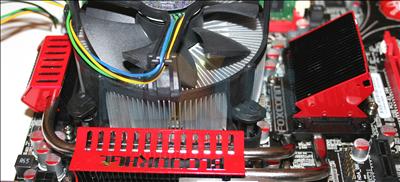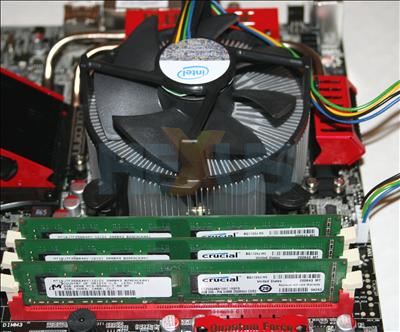The board
If specifications cause excitement that can barely be contained, please head on over here for the complete rundown of the ports and sockets, but we'll remark on the salient points along the way.The Intel X58 has become the de facto standard for high-end chipsets as is supports the latest iteration of Core i7 processors, ranging from the £230 Core i7 920 to the £800 Core i7 965 Extreme Edition.
What makes them kind of special, for a home environment at least, is the provision, on most, for running either ATI or NVIDIA multi-graphics - be it four-way CrossFireX or three-way SLI.
Foxconn's Bloodrage supports both, too, without requiring any end-user modification, be it hardware or software.
The ATX-sized Bloodrage looks impressive in a red-and-black colour scheme, and initial impressions are of a high-end board packed with more features than you'll ever use.
Attention is immediately drawn to the cooling, where heatpipes complete the run from ICH10R southbridge (on the right) to X58 IOH, and through to the power-delivery components.
There's enough space around the cooling to mount an Intel reference heatsink without risking pulling skin off your fingers - an altogether too-common problem on some boards.
The mounting section has two sets of holes - the outer ones take the usual Intel LGA1366 cooler and the inner ones will house standard S775 coolers, meaning that the enthusiast can re-use esoteric cooling equipment without having to reinvest.
Foxconn uses a 14-phase analogue/digital PWM for delivering the juice to the power-sucking components. As you will see in the BIOS section, there's fantastically granular control over many of the settings.
The 8-pin power connector can be a touch difficult to get to but it's no deal-breaker.
As it ships, the cooling is completely passive, which is pretty cool (excuse the pun) for a high-end board. Foxconn also supplies additional hardware to mount on the X58 IOH, which we'll show later on. Bear in mind that the board will work just fine, and even overclock well, with the stock setup.
Looking at it from the other side, another chunky heatsink sits on top of more voltage- and power-regulation components. The red button, between the well-located 24-pin ATX and memory, is used as a fancy reset (FORCE reset) mechanism that reinitialises the CPU, memory-controller and chipset, so not quite a clear CMOS.
One downside of packing so much cooling in to the right-hand side of the board is the limitation imposed on DIMM slots. Core i7's memory-controller uses three 64-bit channels and aggregates bandwidth, so either three or six DIMM slots make sense. We'd have, somehow, liked to have seen the cooling kept intact and another three DIMM slots made available, because the board may well be used in environments that require 6GB+ of onboard RAM.
As such, the three DIMM slots provide DDR3 support right up to 1,800MHz out of the box, according to the literature, but as you will see in the BIOS, 2,133MHz is available at a default CPU reference clock of 133MHz.







